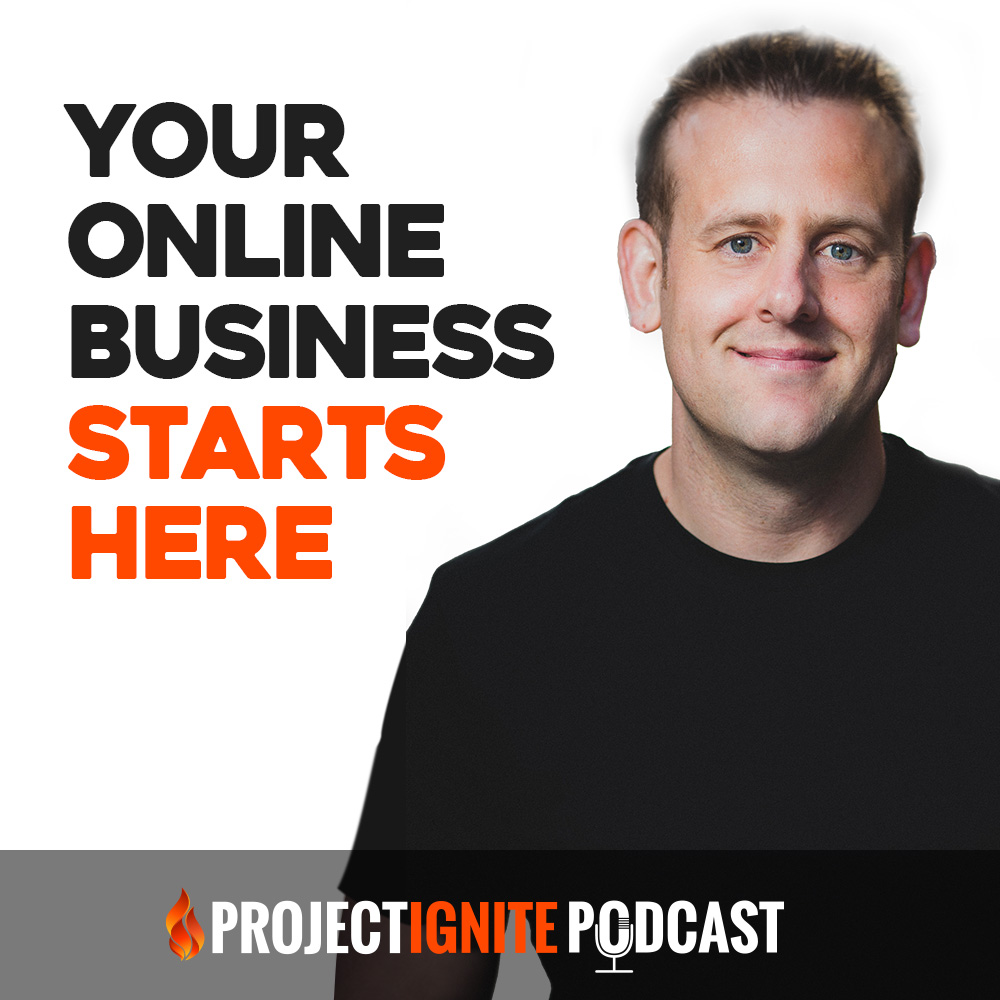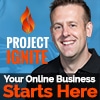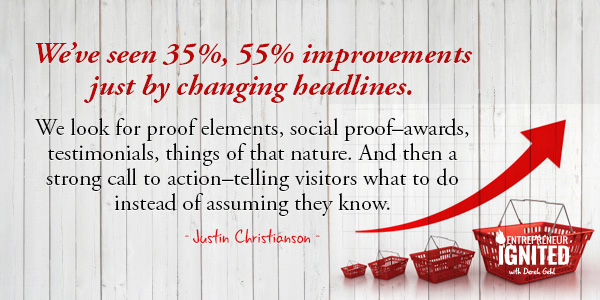Summary:
Justin Christianson is a conversion optimization expert. His company, Conversion Fanatics, and his book of the same title, are designed to simplify and streamline A/B testing–and today he is going to be sharing conversion optimization tips you can start applying today. The importance of testing is so underestimated and it can be hard to get started, but Justin has a few tips and strategies to get the ball rolling for you.
Links:
- Find Justin at ConversionFanatics.com
- We mentioned Google Analytics in this episode, Survey Monkey for optimizing forms, and Crazy Egg Heat Maps to see where people are clicking on specific pages.
Transcript: Conversion Optimization Tips With Justin Christianson
Welcome to the Project Ignite podcast–a podcast designed to skip the hype, skip the BS, and bring you real, actionable tips and strategies to help you grow your business and your income on the Internet. If I’ve done my job, at the end of this podcast, you’ll have a list of actions, tasks, and steps that you can use to start making more money.Today we are diving into a topic I love–conversion optimization. Essentially, that’s getting more visitors at your website to take more action, and buy more stuff. Today’s guest is a conversion fanatic. He’s a thirteen year marketing veteran and best-selling author of the book Conversion Fanatic: How to Double Your Customers, Profit, and Sales with A/B Testing. He’s also the cofounder and president of Conversion Fanatics, which is a full-service conversion optimization company.
This gentleman eats, breathes, and sleeps conversion and today I am going to mine him for his best conversion optimization tips. Without further ado, I’d like to welcome Justin Christianson to the show.
Actually, I learned a lot from you back in the day. I started in 2002 when this whole interweb thing was really kicking off. I started in MLM, and quickly realized that wasn’t the game for me. I found Internet marketing, and affiliate marketing, failed miserably for a handful of years, then found a bit of success and went full-time in 2005.
I was the number one affiliate for one site, and then became a partner there. We grew the company to millions of dollars in profit, and then I sold my share and went into private consulting. People were hung up on the technical aspects of marketing. Then in the last few years, we’ve formalized it, built a team, and really just took it to a whole new level.
Before we started out recording today, you said you’d been dealing with companies with anywhere from $10m to $200m in profits. So you deal with conversion on a pretty significant level.
For everyone listening, whenever I can get a guest like this that’s dealing across multiple businesses in different industries and at such a significant volume, I just love these interviews because you get to see so much more than someone just working in their own business in their own niche.
So let’s start at the beginning. When we talk about conversion optimization, knowing we have beginners and veterans online listening, how do you define conversions? What’s the biggest thing people need to know about optimization?
Optimization is not all about split testing. Split testing is just the tool we use to prove or disprove a hunch. Optimization is finding what makes your visitors tick, and then leading them down the path of least resistance to your end goal.
You have to look at your data. That’s the biggest thing. I saw a statistic recently that 97% of website owners collect data of some sort, but less than 30% actually did something with it.
When’s the last time you logged in to your Analytics account?
You have to look. Your visitors will tell you exactly where they’re having hang ups.
I usually start there. Pick one or two traffic sources. Then, figure out where people are falling out within that path. Based on the analytics, then, we survey our lists to find out what their biggest pain points are. The more information you have on how to best deliver your product, the better off you are.
Then we move to competitive analysis. We look at competitors in the marketplace. We look for the low hanging fruit. You might be getting 2% of your traffic taking up your free trial, but only 5% of that taking your upsell. So your low hanging fruit there would be figuring out how to get more people to take your upsell.

That’s a big friction point. You might have a video sales letter, and your analytics will tell you that 80% of viewers leave at minute three; so you’d want to look at minute three and try to figure out how to push people to minute four.
So I think a lot of people that are listening probably aren’t even looking at their analytics, like you said. I think a lot of people need to start with defining their end goals. Figuring out what they’re working towards. That brings me to my question: we talk about analytics. Where do we start from a tool perspective?
You’re probably using the Cadillac of analytics. But let’s look at the average tools that most people are probably using.
Yeah–I just want to see where they’re going.
What are they paying attention to the most?
We look at the path that they’re taking, and we analyze those existing pages. So we see maybe that the bounce rate is really high on the page. Anything that shows us what’s holding people back.
You might think that people are going one route, but after taking a look at your high traffic pages, you might find that people are taking an entirely different path.
A lot of them are just using Google. Mixpanel has been good. Those are the basics. We don’t try to reinvent the wheel with our analytics. Most people already have Google hooked up and are collecting data, so we just go with that.
Another tool that we leverage is Heat and Click Maps. It couples with the analytics to tell you where on those specific pages people are falling off. We also use Crazy Egg, it’s kind of our favourite.
Okay, here’s where we’re gonna kind of geek out here. This is why I love talking to guys like you, because I have questions too. So for everyone that’s listening, if you’ve never used a Heat Map, it’s basically an overlay of your website that shows you where the most people are clicking.
Taking a step back, one of the challenges I’ve had with Heat Maps is figuring out how much traffic goes to a page before it gets statistically relevant. When it comes to split testing especially, what is enough volume to be statistically relevant? What’s your take on that?
I think you can start seeing some data when you start seeing several thousand unique visitors.
With split testing, we split everything up into three buckets. We have volume of traffic, first–we typically want to run a minimum of 1,000 visitors per variation before we run anything based on that specific data.
But we mostly drive it on the number of conversions. We try to get at least 25 conversions before we start looking at data. Unless, of course, there’s a clear loser right out of the gate, and there’s a landslide difference.
And then we try to run it to 90% significance to account for variation in the platform. But that doesn’t always
That’s kind of a case by case basis. If you’ve got a hundred transactions but equal traffic, every transaction will swing it. So instead of running it longer to try to squeeze out 5% or 10% improvement, we’ll often cut that and go test something else.
You could be doing higher leveraged tests. On huge volumes, that 5% makes a difference, but most companies don’t have that kind of budget.
So if you’re that close and you’re not seeing a 20%+ improvement, cut it and go do something else.
We look at distractions, first. Make sure your page has one specific goal. Typically it’s just with B2B, because in B2C you just have a landing page and ask for an email. You don’t want to have multiple calls to action, and you don’t want to have anything that distracts people from that goal. The leveraging of benefits–nobody cares about the features of the product, but they care that it will solve their problems.
Strong headlines. We’ve seen 35%, 55% improvements just by changing headlines. We look for proof elements, social proof–awards, testimonials, things of that nature. And then a strong call to action–telling visitors what to do instead of assuming they know.
You might have a free trial on, but then at the bottom of the page you might have a demo, or the Contact Us button. So then people might get distracted, and consider taking the demo instead, or just contacting you. It’s aside from the main goal that they came to the website for, which was the free trial.
Or just cluttering up the page. If you have a basic lead generation landing page, having a big fat menu bar that’s pulling everyone in fifteen directions. Just emphasize and leave the call to action. It’s the path of least resistance, right, if there’s 5 different paths to take, you’ll lose conversions.
If you want to get someone into a trial, we emphasize that trial and then supplement a bit if we need to.
If you have a homepage, and you want to pack it with information, that leads to a ton of distractions. So we’d want to use page elements that lead people to the goal–the trial. We use consistency in button colour and calls to action to guide people.
It goes into a multi-step process too. You might go to an e-commerce site and notice that the add to cart button is black, because the rest of the scheme is black. This is part of a test that we ran recently.
So the colour scheme of this site was black, and the shopping cart button was also black, and the next page was black. There was consistency. But we actually tested away from black, and we tried an orange shade. It increased clickthroughs and add to cart by 35%.
Then on that next step, we led them down the path using the same colour button. We want them to add to cart, to go to the checkout, and to actually click submit. All of those buttons are the same colour.
We kind of subconsciously led them down the path with those buttons.
It’s weird, because that’s usually a highly visual market. So it comes down to market, but it also comes down to things like having controls on the video, autoplay or not, placement–all of it factors in.
Majority of the time, a perfectly placed video, we see a 300%+ improvement.
Gotcha. So for everyone listening, quit giving me heck for using autoplay, because it works!
So many people complain about autoplay videos. But numbers don’t lie!
The ongoing debate: where are the trends going in results in terms of long form sales letters, short form sales letters, or VSLs?
Some of the largest benefits in the supplement market are going to questions and a survey type process. It’s short and direct, leads strongly with the benefits, and then goes into an image heavy, benefit driven landing page, or it goes straight into a VSL that’s 15 to 18 minutes long.
It’s a bit skewed. It really depends on what is being sold.
That’s a point for everyone listening here. I want to share as many tips and ideas to take away here, and that’s the thing with split-testing and conversions. Every market is different. What works in one space might not work in another.
In Internet marketing, it’s easy to get caught up with the next big strategy, but what works in one place might not work in another. So what I’m trying to do with Justin here is give you a big picture of what could work. You always need to test.
Yeah. I think that really confused people for awhile, because Facebook ads didn’t work like Adwords did.
Can you walk me through what a survey process looks like from a landing page to a conversion perspective?
It’s typically–Ryan Levesque is the person to talk to about this lately. Start with small questions. Are you a man or a woman? Those are all micro commitments. Then at the end, you ask for an email. Then that takes them into the video process.
A weird example here, is we recently tested it on our own lead generation. We were running pay per click traffic, to a long form survey, and we just weren’t getting the numbers we wanted.
So as a test, we put it into SurveyMonkey, and we got a 1000% increase.
Those micro commitments have really taken off lately, too. In tests I’ve seen, just asking for one simple thing and getting people engaged–when we start something, we want to finish it. I always recognize something as effective when something hooks me.
I just saw that with Kijabi, and during that launch process, at one point before they released the Beta, they brought us into a survey, and by the end of it, I was ready to hand over my credit card.
There’s so many creative ways to do that. Especially with SurveyMonkey.
It’s not insane. It’s pretty cost effective. So starting with that micro commitment is a fantastic strategy.
Let’s talk about traffic sources for a second. How do you approach traffic within your conversion optimization? So we have a website with a few different sources of traffic, and as websites grow, you don’t always have control over where traffic comes from. It kind of goes where it wants to sometimes. How do you optimize for different channels?
Well if you claim one thing in an ad, you need to deliver that on the landing page. I saw an ad recently, for an embroidery company with a 50% off offer. Click on the ad, get to the landing page, and it says nothing about 50% off whatsoever. On the page, it actually said something about 35% off.
Immediately I didn’t know how to claim the offer, so I bounced. It’s so important to carry over that message. You could use the same images, headlines, bullets–make it as close to the ad as possible.
That’s absolutely key. One more area I want to go into here–imagery.
Back in the day, we had long form sales letters with no images at all. How do you use imagery on landing pages to increase conversion?
For one, use them. People are very visual. The images are to break it up. We also use imagery to back up the benefits as much as possible. Instead of having a picture of somebody on the beach with a laptop, have an image that’s directly related to the product.
We ran a test recently for the software market, one image was a woman smiling on a laptop, and the other was a more technical image that highlighted the benefits of that exact solution. We saw a 67% improvement just by highlighting the benefits within that image.
Everything matters in the image, whether you’re using a picture or a photo of something. Test them. Say you’re testing a person, test whether or not they’re smiling. All of those little things matter in the images.
But you need to surround it around your solutions, and use them to drive the benefits of your product.
I don’t think that a lot of thought goes into a lot of the imagery up on websites right now. Your images should support and communicate the benefit.
Everyone listening, hopefully we’ve given you a lot of ideas for testing, and you’ve taken a lot of notes. If I was staring at my website after listening to this podcast, I would decide what I want my goal to be. Then, I want to figure out which pages people are on, and then I want to manipulate those pages to get people to our end goal by testing.
Any final thoughts Justin?
Always be testing. That’s a good mantra.
Thank you for being here, Justin. Where can people find more of you?
Alright everyone, that was conversion expert Justin Christianson. As always, the transcript and show notes will be up at ProjectIgnite.com/podcast. If you haven’t done so already, you can subscribe on iTunes–just look up Project Ignite, Derek Gehl, or Internet Marketing and I’ll show up! If you’re an Android user, just get us on Soundcloud!
Also, if you like what you hear–leave a review, tell us what you think. I love to hear what you think. Your feedback is what gives me the momentum and motivation to keep creating this podcast for you.
Now it’s time to take the tips, tools, and strategies that we’ve learned from Matt here today, and apply the final essential ingredient to make this all work for you: that ingredient is action. Go forth, take action, and stay tuned for more info-packed episodes of the Project Ignite podcast–a podcast designed to make this whole internet business thing easier and more profitable.
This is Derek Gehl, signing off.















